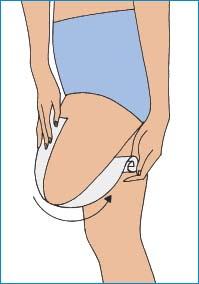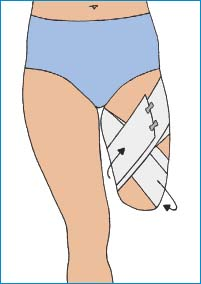Stump and Prosthesis Care
Patient care immediately after limb amputation includes monitoring drainage from the stump, managing pain, reducing edema, positioning the affected limb, assisting with exercises prescribed by a physical therapist, and wrapping and conditioning the stump. Postoperative care of the stump varies slightly, depending on the amputation site (arm or leg) and the type of dressing applied to the stump (elastic bandage or plaster cast).
After limb amputation and stump healing, patient care includes routine daily care, such as proper hygiene and continued muscle-strengthening exercises. As the patient recovers from the physical and psychological trauma of amputation, he will need to learn correct procedures for routine daily care of the stump and any prosthesis he might have. A plastic prosthesis—the most common type—typically must be cleaned, lubricated, and checked for proper fit.
Equipment
For Postoperative Stump Care
Gloves ▪ pressure dressing ▪ abdominal (ABD) pad ▪ suction equipment, if ordered ▪ overhead trapeze ▪ 1″ adhesive tape or bandage clips ▪ trochanter roll (for a leg) ▪ elastic stump shrinker or 4″ elastic bandage ▪ Optional: tourniquet (as a last resort to control bleeding).
For Ongoing Stump or Prosthetic Care
Mild soap or alcohol pads ▪ stump socks or athletic tube socks ▪ two washcloths ▪ two towels ▪ appropriate lubricating oil.
Implementation
Confirm the patient’s identity using at least two patient identifiers according to your facility’s policy.1
Explain the procedure to the patient.
Perform routine postoperative care. Frequently assess respiratory status and level of consciousness, monitor vital signs and IV infusions, check tube patency, and provide for the patient’s comfort, pain management, and safety.
Monitoring Stump Drainage
Because gravity causes fluid to accumulate at the stump, frequently check the amount of blood and drainage on the dressing. Notify the doctor if accumulations of drainage or blood increase rapidly. If excessive bleeding occurs, notify the doctor immediately and apply a pressure dressing or compress the appropriate pressure points. If this doesn’t control bleeding, use a tourniquet only as a last resort.
Tape the ABD pad over the moist part of the dressing as necessary. Doing so provides a dry area to help prevent bacterial infection.
Positioning the Extremity
Elevate the extremity for the first 24 hours to reduce swelling and promote venous return.
To prevent contractures, position an arm with the elbow extended and the shoulder abducted.
To correctly position a leg, elevate the foot of the bed slightly and place a trochanter roll against the hip to prevent external rotation.
Nursing Alert
Don’t place a pillow under the thigh to flex the hip because this positioning can cause hip flexion contracture. For the same reason, tell the patient to avoid prolonged sitting.
After a below-the-knee amputation, maintain knee extension to prevent hamstring muscle contractures.
After any leg amputation, place the patient on a firm surface in the prone position for at least 2 hours a day, with his legs close together and without pillows under his stomach, hips, knees, or stump, unless this position is contraindicated. This position helps prevent hip flexion, contractures, and abduction; it also stretches the flexor muscles.
Assisting with Prescribed Exercises
After arm amputation, encourage the patient to exercise the remaining arm to prevent muscle contractures. Help the patient perform isometric and range-of-motion (ROM) exercises for both shoulders, as prescribed by the physical therapist, because use of a prosthesis requires both shoulders.
After leg amputation, stand behind the patient and, if necessary, support him with your hands at his waist during balancing exercises.
Instruct the patient to exercise the affected and unaffected limbs to maintain muscle tone and increase muscle strength. The patient with a leg amputation may perform push-ups, as ordered (in the sitting position, arms at his sides), or pull-ups on the overhead trapeze to strengthen his arms, shoulders, and back in preparation for using crutches.
Wrapping A Stump
Proper stump care helps protect the limb, reduces swelling, and prepares the limb for a prosthesis. As you perform the procedure, teach it to the patient.
Start by obtaining two 4″ elastic bandages. Center the end of the first 4″ bandage at the top of the patient’s thigh. Unroll the bandage downward over the stump and to the back of the leg (as shown below).
 |
Make three figure-eight turns to adequately cover the ends of the stump. As you wrap, be sure to include the roll of flesh in the groin area. Use enough pressure to ensure that the stump narrows toward the end so that it fits comfortably into the prosthesis.
 |
Use the second 4” bandage to anchor the first bandage around the waist. For a below-the-knee amputation, use the knee to anchor the bandage in place. Secure the bandage with clips or adhesive tape. Check the stump bandage regularly, and rewrap it if it bunches at the end.
Stay updated, free articles. Join our Telegram channel

Full access? Get Clinical Tree


Get Clinical Tree app for offline access
